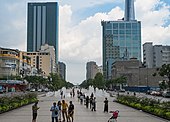Nguyễn Huệ Boulevard
| Nguyễn Huệ Pedestrian Boulevard | |
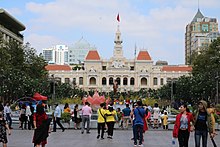 Ho Chi Minh City Hall as seen from Nguyễn Huệ Boulevard | |
| Native name | Đường Nguyễn Huệ, Đại lộ Nguyễn Huệ, Phố đi bộ Nguyễn Huệ (Vietnamese) |
|---|---|
| Former name(s) | Boulevard Charner |
| Length | 670 m (2,200 ft) |
| Width | 64 metres (210 ft) |
| Location | Bến Nghé, District 1, Thành phố Hồ Chí Minh |
| Nearest metro station | 1 Opera House station |
| Coordinates | 10°46′27″N 106°42′13″E / 10.774112°N 106.703619°E |
| Northwest end | Lê Thánh Tôn Street |
| Major junctions | Lê Lợi Boulevard |
| Southeast end | Tôn Đức Thắng Boulevard |
| Construction | |
| Completion | 1887 |
Nguyễn Huệ Boulevard (Vietnamese: Đường Nguyễn Huệ) is a boulevard in District 1, downtown Ho Chi Minh City, Vietnam.[1] Being one of Saigon's oldest thoroughfares, the boulevard has undergone several transformations; it is currently a famous pedestrian street in the city.[2]
The boulevard stretches from Lê Thánh Tôn Street, right across from Ho Chi Minh City Hall, to Tôn Đức Thắng Boulevard (Bạch Đằng Quay, the Saigon River waterfront).[1]
History
[edit]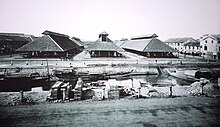
The boulevard was originally a canal known as Kinh Lớn (Grand Canal), which linked the former Citadel of Saigon (the Thành Quy) to Saigon River. In the first two decades after the French conquest of Saigon, the canal remained an important waterway, as the central market was then located on its bank.[3] The two quayside streets along the canal were designated by n° 18, before they were officially named Quai Charner (on the right bank) and Quai Rigault de Genouilly (on the left bank) in 1865. Due to the pestilential odors emanating from the canal, local residents had soon requested that it be filled in. However, it took eighteen years of discussions for this to be achieved in 1886–1887. The resulting wide thoroughfare was henceforth named boulevard Charner.[4]
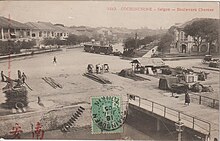
From 1926, the boulevard had two wide central avenues separated by a thin strip of grass, which was ordered by the former Saigon mayor Rouelle.[4] In 1955, it was renamed Nguyễn Huệ Boulevard by the South Vietnamese government.[5]
Nguyen Hue pedestrian street
[edit]In October 2014, the government of Ho Chi Minh City decided to convert the middle lanes of the boulevard into a pedestrian square. The project was completed on April 29, 2015.[2] During weekend evenings, the entire boulevard is pedestrianized.
Buildings
[edit]South-east to North-west; numerical order, odd for West side and even for the East side
| Address | Alternative name | Primary tenant(s) |
|---|---|---|
| 3-5-7 Nguyễn Huệ Boulevard | BenThanh Tourist Office | |
| 8 Nguyễn Huệ Boulevard | Vạn Thịnh Phát (VTP) Office Service Center | |
| 10 Nguyễn Huệ Boulevard | Vinatex Building | |
| 9-11 Nguyễn Huệ Boulevard | Cholon Tourist Office | |
| 19–25 Nguyễn Huệ Boulevard | Bitexco Office Building (BOB) | Sai Gon Joint Stock Commercial Bank Office |
| 22–36 Nguyễn Huệ Boulevard | Saigon Times Square | The Reverie Saigon Hotel, Deloitte |
| 35 Nguyễn Huệ Boulevard | Harbor View Tower | ADVisory Company, Bangkok Bank, Payoo Cooperation |
| 37 Nguyễn Huệ Boulevard | Ho Chi Minh City State Treasurey | |
| 42 Nguyễn Huệ Boulevard | 42 Nguyễn Huệ Apartment | FAHASA (in the podium), numerous coffee shops on the storeys |
| 44 Nguyễn Huệ Boulevard | Trung Thủy Building | Vietinbank, Asia Commercial Bank |
| 55–57 Nguyễn Huệ Boulevard | Amigo Grill Restaurant | |
| 63 Nguyễn Huệ Boulevard | Saigon Prince Hotel | |
| 56-66 Nguyễn Huệ Boulevard | Palace Saigon Hotel | Calibre Charner Coffee |
| 68 Nguyễn Huệ Boulevard | Vietcomreal Bulding | |
| 68A Nguyễn Huệ Boulevard | Oscar Saigon Hotel | |
| 72 Nguyễn Huệ Boulevard | Eximbank Trading Office | |
| 87 Nguyễn Huệ Boulevard | The Gangs Restaurant | |
| 110 Nguyễn Huệ Boulevard | Union Square Saigon | Ho Chi Minh Statue, Louis Vuitton, Mandarin Oriental Hotel Saigon |
| 115 Nguyễn Huệ Boulevard | Sunwah Tower | Citibank Vietnam, KPMG, Air China |
| 123 Nguyễn Huệ Boulevard | McDonald's Restaurant | |
| 127-129-129A Nguyễn Huệ Boulevard | Fiditourist Office Building | |
| 133 Nguyễn Huệ Boulevard | Kim Đô - Royal Hotel Saigon | |
| 135 Nguyễn Huệ Boulevard | Saigon Tax Trade Centre | Demolished; wait for renovation |
| 141 Nguyễn Huệ Boulevard | Rex Hotel | Chanel |
Public transportation
[edit]Buses
[edit]Being a tourist street, tourist buses are commonly seen on the Nguyễn Huệ Boulevard.
Metro
[edit]A metro line is being built. The Line 1, Ho Chi Minh City Metro would cross beneath Nguyễn Huệ Boulevard. The nearest station, the Opera House station has many exits to the boulevard.
Nguyen Hue Flower Street
[edit]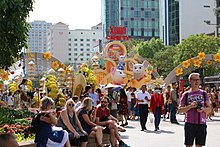
Nguyen Hue Flower Street, or natively known as Đường hoa Nguyễn Huệ, is the common name of Nguyễn Huệ Boulevard during the lunar new year festival. During the festival, the street is decorated for the occasion and are exclusively for pedestrians. The tradition started in 2004, which previously known as Flower Market Nguyễn Huệ.
During the 20th century, the street is commonly a marketplace for trading flowers during the end of the lunar years. Vendors would come from the port at Bạch Đằng Quay. As such, during these years, the street is a common attraction for citizens to sightseeing and enjoy the Tết atmosphere.
After 2003, the city relocated the flower market to 23 Tháng 9 park. In 2004, the city started the tradition to set up flowers decoration on the street, designated as a sightseeing area during new year times. Since then, the name Nguyen Hue flower street is born. The street during this time is for pedestrians, and transportations are forbidden on the street.
In February 2015, the boulevard was under construction, so the Flower Street event was held on the nearby Hàm Nghi Boulevard. Following the boulevard's conversion into a pedestrian street, the tradition continues, with flowers decorated during the new year time. Motorbike routes continued to be blocked, but this time with additional nearby streets like Lê Lợi. During Tet 2023, in addition to the Flower Street, a book street event was held on Lê Lợi Boulevard.
The Nguyễn Huệ flower street are considered to be a culture and tourist event during the new year time, attract many citizens, tourists, as well as home-coming overseas Vietnamese.
References
[edit]- ^ a b "Map of Ho Chi Minh City". HCM CityWeb.
- ^ a b Brebbia, C. A.; Zubir, S. S.; Hassan, A. S., eds. (2017). Sustainable Development and Planning VIII. WIT Press. pp. 301–302.
- ^ Tran, Quynh (June 11, 2017). "How Saigon's iconic Nguyen Hue Street has transformed over 150 years".
- ^ a b Baudrit, André (1943). Guide historique des rues de Saigon. Saigon: S.I.L.I. pp. 147–148.
- ^ Corfield, Justin (2014). Historical Dictionary of Ho Chi Minh City. Anthem Press. p. 356.

